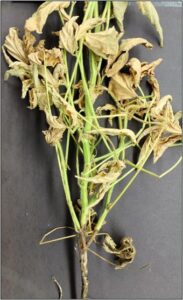Phytophthora Crown and Stem Rot in Soybean: A Recurrent Disease in Illinois
Soybean Phytophthora root, crown, and stem rot is one of the most significant diseases affecting soybean production worldwide. Multiple species of Phytophthora, a group of related soilborne pathogens, can infect soybean and cause primarily root rots while Phytophthora sojae causes root, crown, and stem rot, resulting in more severe symptoms and increased yield loss. In the state of Illinois, it ranks among the top yield-reducing diseases, following white mold and soybean cyst nematode (SCN). Across the state, Phytophthora has been diagnosed in nearly all counties, with higher prevalence in regions of intensive soybean production (Figure 1).

This disease can affect soybeans at all growth stages, from seedling emergence to flowering and even close to harvest. Its spread in the field is favored by warm, saturated soils. Under these conditions, the pathogen produces mobile spores called zoospores, which move toward soybean root exudates and infect nearby roots, leading to plant-to-plant spread.
The recent extended periods of rainfall and warm temperatures in Illinois may have created highly favorable conditions for the proliferation and movement of P. sojae in fields, increasing the risk of infection and yield loss.
Although symptoms of Phytophthora infection may not appear immediately in the plants, they often become evident later in the season, especially when the plant enters senescence or experiences additional biotic or abiotic stress. Stressed plants are more susceptible to disease expression. Common abiotic stressors include compacted soils, nutrient deficiencies, and drought, while biotic stressors may involve the presence of other pathogens, such as Fusarium virguliforme, the causal agent of Sudden Death Syndrome.
Initial symptoms include reduced emergence and rotting of the hypocotyl and cotyledons (Figure 2). In seedlings, symptoms typically include rapid yellowing, wilting, defoliation, and brown discoloration at the base of the stem (Figure 3). In more mature plants, symptoms may manifest as reduced vigor, followed by progressive decline and plant death as the season advances. Foliar symptoms often begin with a general yellowing of the lower leaves, which gradually moves upward, leading to wilting and eventual plant death (Figure 4).



The diagnosis of this pathogen in the laboratory begins with a visual assessment of the characteristic symptoms caused by the disease. This is supported by information provided by the client, such as the distribution of symptomatic plants in the field, weather conditions prior to symptom development, the cultivar planted, and any fungicide applications (see the Plant Clinic Diagnostic submission form). Following this, a detailed microscopic examination of the roots is conducted to identify possible pathogen structures (Figure 5). When necessary, root tissue is cultured on a rich medium to promote fungal growth for a second microscopic observation. Finally, a serological Enzyme-Linked Immunosorbent Assay (ELISA) test is performed to confirm the presence of the pathogen (Figure 6).


Managing Phytophthora sojae in soybeans requires an integrated strategy:
- Resistant Varieties – The most effective approach. Use soybean varieties with Rps genes (like Rps1c, Rps1k, Rps3a, or Rps6), but rotate genes to avoid resistance breakdown Link.
- Moisture Management – Improve drainage using tiles or proper tillage to reduce favorable conditions for the pathogen.
- Seed Protectant – Essential for early-stage protection. Effective fungicides include mefenoxam, metalaxyl, oxathiapiprolin and ethaboxam Link. Rotating active ingredients can reduce the possibility of resistance.
- Crop Rotation – Reduces inoculum over time but must be used with other tactics due to long-term survival of the pathogen.
- Field Monitoring – Regular scouting after rains helps detect the disease early for future planning Link.
Soybean fields typically appear healthy and green throughout much of the growing season. However, by late summer, yellowing leaves and wilting symptoms often begin to appear. These symptoms are commonly caused by diseases such as Fusarium root rot, Sudden Death Syndrome, Soybean Cyst Nematode (SCN), and Phytophthora root and stem rot. Affected areas in the field often show distinct yellow patches, which can be mistaken for normal plant senescence or abiotic stress as the season ends. To differentiate disease symptoms from natural aging or environmental issues, symptomatic plants should be carefully removed from the soil and examined. Key diagnostic signs include visible structures of pathogens such as sclerotia, which are produced by white mold (Sclerotinia sclerotiorum).
If no obvious signs are present, diagnostic laboratories offer a range of tools to identify potential pathogens. These include microscopic, serological, cultural, and molecular methods, as previously described. For instructions on how to collect and submit plant samples for diagnosis, please visit the University of Illinois Plant Clinic: How to Prepare Your Sample.
Greenhouse and field trials are essential for testing new disease management strategies.
The Plant Clinic produces inoculum, including Phytophthora sojae, to help researchers evaluate the effectiveness of new chemistries and genetics in protecting crops.
For questions about plant sampling, laboratory diagnostics, pest and pathogen management, or inoculum, contact the University of Illinois Plant Clinic at 217-333-0519 or email plantclinic@illinois.edu.





